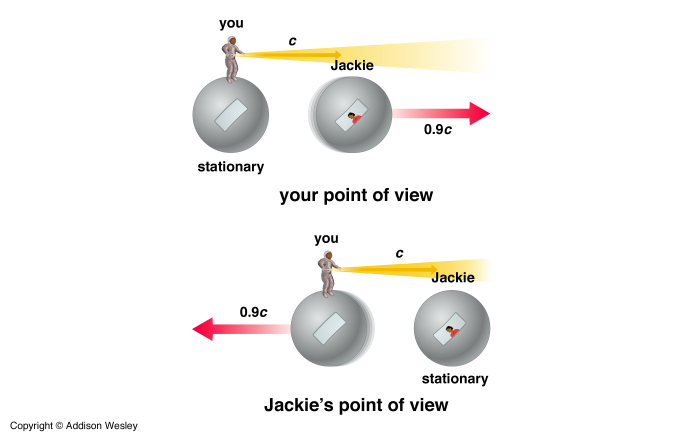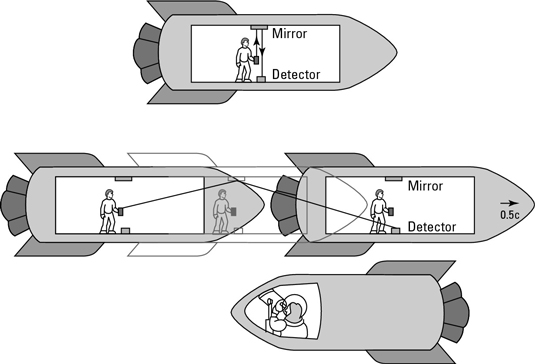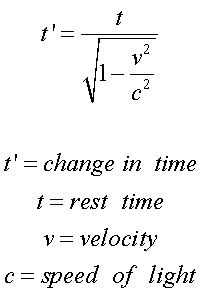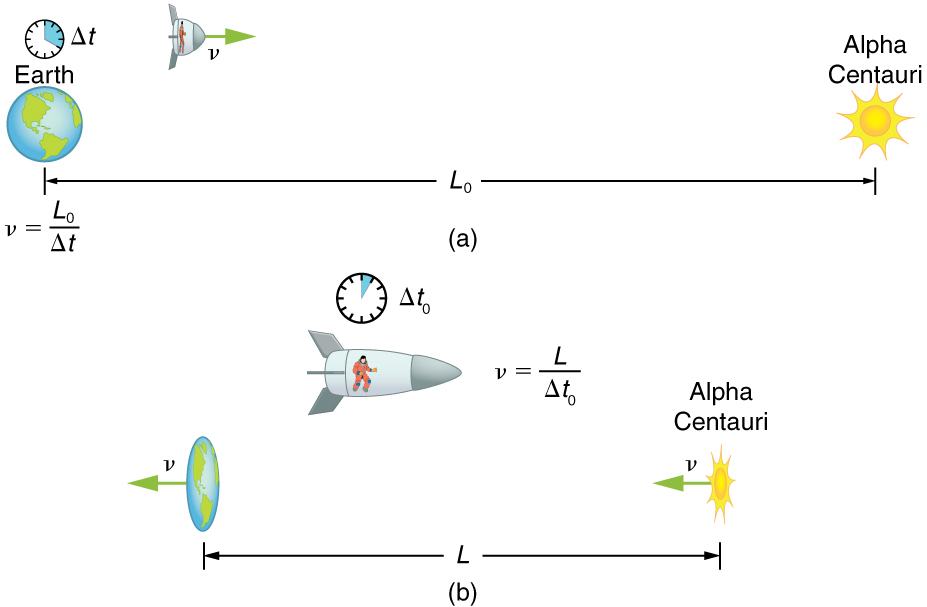Einstein's Theory of Special Relativity: Difference between revisions
| Line 70: | Line 70: | ||
In particle accelerators, particles are moving very close to the speed of light where the length and time effects are large. This has allowed us to clearly verify that length contraction and time dilation do occur. | In particle accelerators, particles are moving very close to the speed of light where the length and time effects are large. This has allowed us to clearly verify that length contraction and time dilation do occur. | ||
[[File:gamma.gif]] | |||
===Time Dilation for Particles=== | ===Time Dilation for Particles=== | ||
Revision as of 03:14, 29 November 2015
Speical Relativity
Einstein's theory of Special relativity is based on the speed of light being constant for everyone. Einstein came to this conclusion in 1905 after experimental evidence showed that the speed of light didn't change as the Earth swung around the Sun. This result was surprising to physicists because the speed of most other things does depend on what direction the observer is moving.

Einstein said that all observers will measure the speed of light to be 186,000 miles per second, no matter how fast and what direction they are moving."If you are in a spaceship that is traveling at the speed of light, and you turn on the headlights, does anything happen?"
The answer is the headlights turn on normally, but only from the perspective of someone inside the spaceship. For someone standing outside watching the ship fly by, the headlights do not appear to turn on: light comes out but it takes an eternity for the beams to get ahead of the spaceship.
These contradictory versions arise because rulers and clocks —If the speed of light is to be held constant as Einstein said, then time and space cannot be absolute; they must be subjective. For instance, a 100-foot-long spaceship traveling at 99.99 percent the speed of light will appear one foot long to a stationary observer, but it will remain its normal length for those onboard.
Perhaps even weirder, time passes slower the faster one goes. If a twin rides in the speeding spaceship to some distant star and then comes back, she will be younger than her sister who stayed on Earth.
. Mass, too, depends on speed. The faster an object moves, the more massive it becomes. In fact, no spaceship can ever reach 100 percent of the speed of light because its mass would grow to infinity. This relationship between mass and speed is often expressed as a relationship between mass and energy:
![]() , where E is energy, m is mass and c is the speed of light.
, where E is energy, m is mass and c is the speed of light.
Relativistic Definitions
- Physicists call particles with v/c comparable to 1 "relativistic" particles. Particles with v/c << 1 (very much less than one) are "non-relativistic."
The image above explains how the point of view relating the speed of light can be different according to the two different reference point.
Occurrence
Theoritical Basis for Special Relativity
Einstein's theory of special relativity results from two statements -- the two basic postulates of special relativity:
- The speed of light is the same for all observers, no matter what their relative speeds.
- The laws of physics are the same in any inertial (that is, non-accelerated) frame of reference. This means that the laws of physics observed by a hypothetical observer traveling with a relativistic particle must be the same as those observed by an observer who is stationary in the laboratory.
Given these two statements, Einstein showed how definitions of momentum and energy must be refined and how quantities such as length and time must change from one observer to another in order to get consistent results for physical quantities such as particle half-life.
The speed of light is the same for all observers, no matter what their relative speeds
- "The speed of light will be seen to be the same relative to any observer, independent of the motion of the observer"is the crucial idea that led Einstein to formulate his theory. It means we can define a quantity c, the speed of light, which is a fundamental constant of nature.
- Note that this is quite different from the motion of ordinary, massive objects. If I am driving down the freeway at 50 miles per hour relative to the road, a car traveling in the same direction at 55 mph has a speed of only 5 mph relative to me, while a car coming in the opposite direction at 55 mph approaches me at a rate of 105 mph. Their speed relative to me depends on my motion as well as on theirs.
The laws of physics are the same in any inertial (that is, non-accelerated) frame of reference
- This is the idea that we can formulate rules of nature which do not depend on our particular observing situation. This does not mean that things behave in the same way on the earth and in space, e.g. an observer at the surface of the earth is affected by the earth's gravity, but it does mean that the effect of a force on an object is the same independent of what causes the force and also of where the object is or what its speed is.
- Einstein developed a theory of motion that could consistently contain both the same speed of light for any observer and the familiar addition of velocities described above for slow-moving objects. This is called the special theory of relativity, since it deals with the relative motions of objects.
Gamma(γ)
The measurable effects of relativity are based on gamma. Gamma depends only on the speed of a particle and is always larger than
By definition:  c is the speed of light and v is the speed of the object in question
c is the speed of light and v is the speed of the object in question
For example, when an electron has traveled ten feet along the accelerator it has a speed of 0.99 c, and the value of gamma at that speed is 7.09. When the electron reaches the end of the linac, its speed is 0.99999999995 c where gamma equals 100,000.
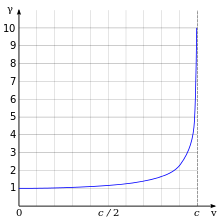
Relativistic Effects
Length Contraction and Time Dilation
One of the strangest parts of special relativity is the conclusion that two observers who are moving relative to one another, will get different measurements of the length of a particular object or the time that passes between two events.
Consider two observers, each in a space-ship laboratory containing clocks and meter sticks. The space ships are moving relative to each other at a speed close to the speed of light. Using Einstein's theory:
- Each observer will see the meter stick of the other as shorter than their own, by the same factor gamma (gamma- defined above). This is called length contraction .
- Each observer will see the clocks in the other laboratory as ticking more slowly than the clocks in his/her own, by a factor gamma. This is called time dilation .
In particle accelerators, particles are moving very close to the speed of light where the length and time effects are large. This has allowed us to clearly verify that length contraction and time dilation do occur.
Time Dilation for Particles
Particle processes have an intrinsic clock that determines the half-life of a decay process. However, the rate at which the clock ticks in a moving frame, as observed by a static observer, is slower than the rate of a static clock. Therefore, the half-life of a moving particles appears, to the static observer, to be increased by the factor gamma.
For example, let's look at a particle known as a tau. In the frame of reference where the tau particle is at rest, its lifetime is known to be approximately 3.05 x 10 -13 s. To calculate how far it travels before decaying, we could try to use the familiar equation distance equals speed times time. It travels so close to the speed of light that we can use c = 3x10^8 m/sec for the speed of the particle. If you do the calculation you find the distance traveled should be 9.15 x 10 -5 meters.
- d = v t
- d = (3 x 10^8 m/sec)( 3.05 x 10^-13 s) = 9.15 x 10^-5 m
Observations particles with a variety of velocities have shown that time dilation is a real effect. In fact the only reason cosmic ray muons ever reach the surface of the earth before decaying is the time dilation effect.
Length Contraction
Instead of analyzing the motion of the tau from our frame of reference, we could ask what the tau would see in its reference frame. Its half-life in its reference frame is 3.05 x 10^-13 s. This does not change. The tau goes nowhere in this frame.
How far would an observer, sitting in the tau rest frame, see an observer in our laboratory frame move while the tau lives?[1]
We just calculated that the tau would travel 1.8 mm in our frame of reference. Surely we would expect the observer in the tau frame to see us move the same distance relative to the tau particle. Not so says the tau-frame observer -- you only moved 1.8 mm/gamma = 0.09 mm relative to me. This is length contraction.
How long did the tau particle live according to the observer in the tau frame? We can rearrange d = v x t to read t = d/v . Here we use the same speed, Because the speed of the observer in the lab relative to the tau is just equal to (but in the opposite direction) of the speed of the tau relative to the observer in the lab, so we can use the same speed. So time = 0.09 x 10^-3 m/(3 x 10^8) m/sec = 3.0 x 10^-13 sec. This is the half-life of the tau as seen in its rest frame, just as it should be!
Examples
Simple
Problem
Solution
Middling
Problem
Solution
Difficult
Problem
Solution
Connectedness
Einstein's Theory of Special Relativity is connected to the general relativity. The movie "Interstellar" made me interested about the Einstein's Theorem. It is not directly related to Business major, but there are some interesting industrial applications.
Built at a cost of over $10 billion mainly for military navigation, GPS has rapidly transformed itself into a thriving commercial industry. The system is based on an array of 24 satellites orbiting the earth, each carrying a precise atomic clock. Apart from the obvious military uses, GPS is finding applications in airplane navigation, oil exploration, wilderness recreation, bridge construction, sailing, and interstate trucking, to name just a few.
The satellite clocks are moving at 14,000 km/hr in orbits that circle the Earth twice per day, much faster than clocks on the surface of the Earth, and Einstein's theory of special relativity says that rapidly moving clocks tick more slowly, by about seven microseconds (millionths of a second) per day.
Also, the orbiting clocks are 20,000 km above the Earth, and experience gravity that is four times weaker than that on the ground. Einstein's general relativity theory says that gravity curves space and time, resulting in a tendency for the orbiting clocks to tick slightly faster, by about 45 microseconds per day. The net result is that time on a GPS satellite clock advances faster than a clock on the ground by about 38 microseconds per day.
To determine its location, the GPS receiver uses the time at which each signal from a satellite was emitted, as determined by the on-board atomic clock and encoded into the signal, together the with speed of light, to calculate the distance between itself and the satellites it communicated with. The orbit of each satellite is known accurately. Given enough satellites, it is a simple problem in Euclidean geometry to compute the receiver's precise location, both in space and time. To achieve a navigation accuracy of 15 meters, time throughout the GPS system must be known to an accuracy of 50 nanoseconds, which simply corresponds to the time required for light to travel 15 meters.
GPS accounts for relativity by electronically adjusting the rates of the satellite clocks, and by building mathematical corrections into the computer chips which solve for the user's location. Without the proper application of relativity, GPS would fail in its navigational functions within about 2 minutes.
Interesting Facts About Special Relativity
- Philosopher David Hume's 1738 "A Treatise of Human Nature" was a big influence on Einstein's thinking about space and time. Hume was an empiricist and skeptic, believing that scientific concepts must be based on experience and evidence, not reason alone. He also held that time did not exist separately from the movement of objects. "It is very well possible that without these philosophical studies I would not have arrived at the solution," Einstein wrote
- In 1905, Albert Einstein based a new theory on two principles. First, the laws of physics appear the same to all observers. Second, he calculated that the speed of light-186,000 miles per second (299,338 kilometers per second)- is unchanging. Prior to Einstein, scientists believed that space was filled with luminiferous aether that would cause the speed of light to change depending on the relative motion of the source and the observer.
- As a result of these principles, Einstein deduced that there is no fixed frame of reference in the universe. Everything is moving relative to everything else, hence Einstein's theory of relativity. It is known as special relativity because it applies only to special cases: frames of reference in constant, unchanging motion. In 1915, Einstein published the general theory of relativity, which applies to frames that are accelerating with regard to each other.
- A fast-moving object appears shorter along the direction of motion, relative to a slow-moving one. This effect is very subtle until the object travels close to the speed of light.
- As a result of
 , a fast-moving object appears to have increased masses relative to a slow-moving one. This is due to the fact that increasing an object's velocity increases its kinetic energy and, therefore, its mass.
, a fast-moving object appears to have increased masses relative to a slow-moving one. This is due to the fact that increasing an object's velocity increases its kinetic energy and, therefore, its mass.
History
Put this idea in historical context. Give the reader the Who, What, When, Where, and Why.
See also
Further reading
- Living reviews in relativity - An article about relativity theorem with numerical values
- Reflections on Relativity - A book about Einstein's Theory of Relativity with detail explanations
External links
- Sixty Symbols-A Youtube video for time dilation using gamma factor
- List of relativistic equations-A list of relativistic equations and its explanation
- Principle of relativity
- Speical Relativity
References
https://www.grc.nasa.gov/www/k-12/airplane/thermo0.html http://hyperphysics.phy-astr.gsu.edu/hbase/thermo/thereq.html

